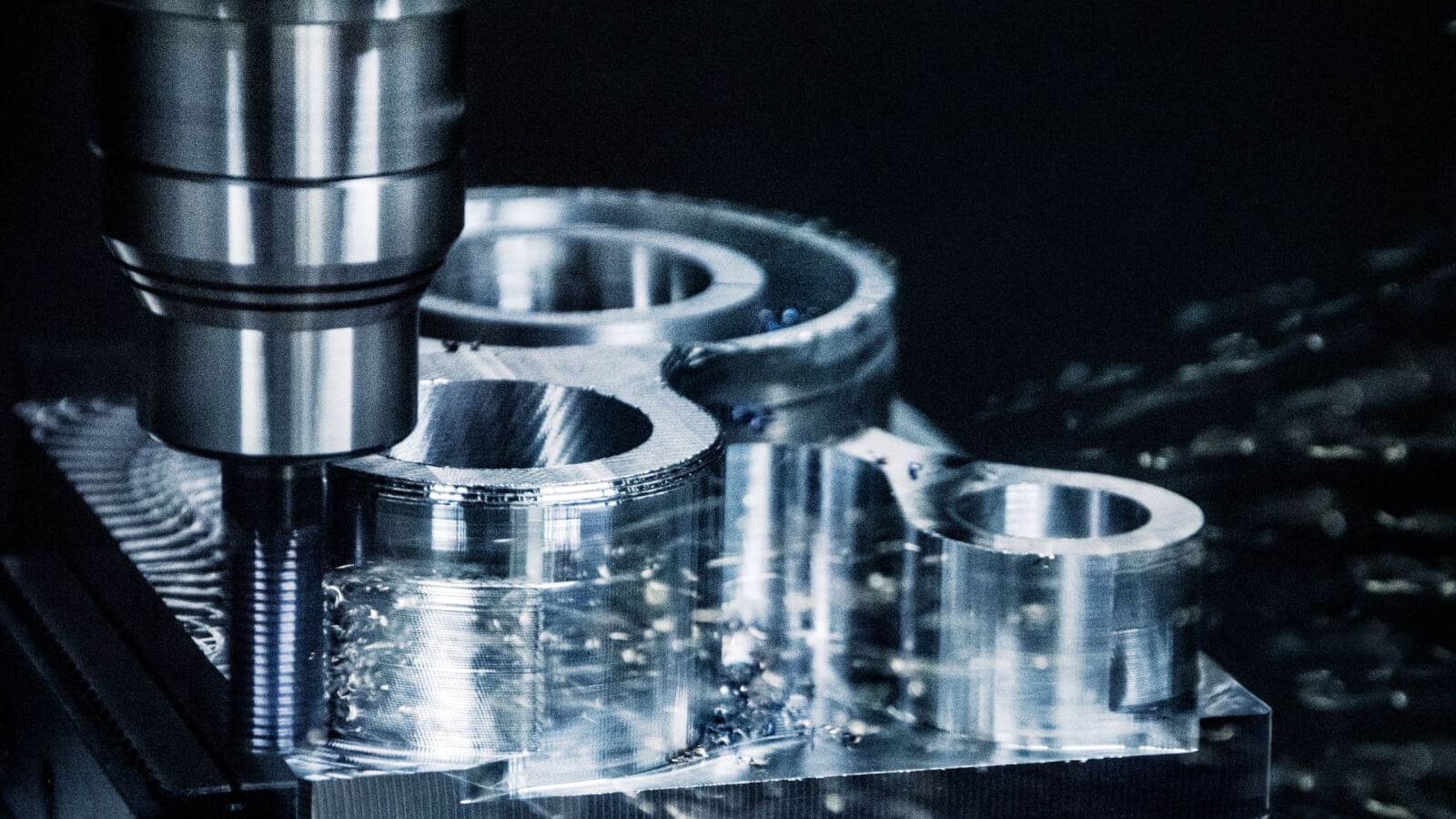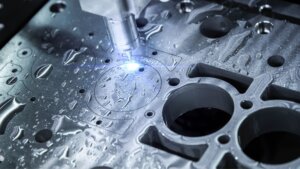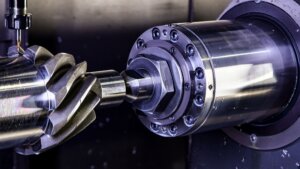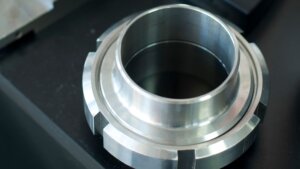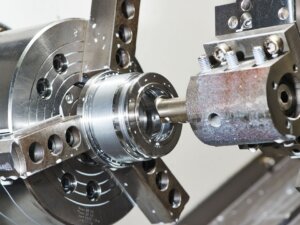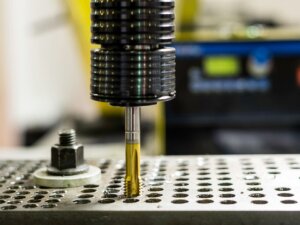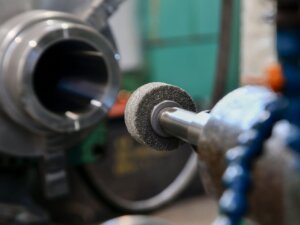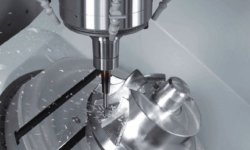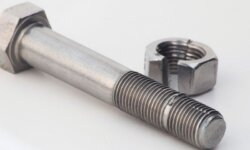In the world of advanced manufacturing and engineering, certain materials like Inconel stand out for their remarkable properties and the challenges they present during machining.
Inconel, a name synonymous with strength, durability, and resistance to extreme environments, is one such material.
This guide dives deep into the intricacies of Inconel machining, offering insights and strategies to navigate its complexities efficiently.
What is Inconel?
Inconel, a family of nickel-chromium-based superalloys, is celebrated for its remarkable ability to withstand extreme pressures and temperatures without losing its integrity. Its resilience against oxidation and corrosion makes it a material of choice in challenging operating environments.
For machinists and engineers alike, Inconel is synonymous with durability and strength, offering a solution to some of the most demanding applications in industries like aerospace, marine, and energy.
The alloy’s unique properties, including high temperature and corrosion resistance, make it an indispensable resource in the quest for CNC machining materials that can endure harsh conditions while maintaining their structural integrity.
Is Inconel difficult to machine?
Yes, machining Inconel is a complex undertaking that requires expertise and precision. Its renowned strength and resilience, while beneficial for applications facing harsh environments, present significant challenges when it comes to shaping the material into desired forms.
The process demands not just specialized cutting tools but also a nuanced approach to machining parameters to effectively manage the alloy’s work hardening rate and high heat generation. Inconel’s machining difficulty poses a challenge that only the most skilled machinists, equipped with the right tools and knowledge, can navigate.
What is the Machinability of Inconel?
In the realm of advanced materials, Inconel is as a standout with its machinability rating pegged at 12% on the AISI Machinability Index. This figure, while seemingly modest when compared to Aluminum and Steel, encapsulates Inconel’s unique standing in the manufacturing world, paving the way for a deeper exploration of its machining challenges and solutions.
What Makes Inconel Machining Challenging?
The journey into machining Inconel is akin to navigating a labyrinth of technical hurdles, each demanding a precise blend of skill, knowledge, and technology.
Let’s define the core challenges that define the Inconel machining experience.
High Work Hardening Rate
Inconel’s penchant for work hardening is akin to steel’s resistance when tempered, presenting a formidable challenge to machinists. This characteristic necessitates a strategic approach to machining, where understanding and anticipation become as crucial as the cutting tool in hand.
High Cutting Forces and Tool Wear
The robustness of Inconel translates into elevated cutting forces, leading to accelerated wear on cutting tools. This phenomenon not only tests the mettle of the tools but also the machinists’ ability to adapt and strategize for longevity.
Significant Heat Generation During Machining
Inconel’s resistance to deformation under high temperatures is a double-edged sword, resulting in significant heat generation during machining. This heat challenge requires a meticulous approach to cooling and tool selection, ensuring that the integrity of both the workpiece and tool remains uncompromised.
Risk of Workpiece Deflection
The tenacity of Inconel also introduces the risk of workpiece deflection, a subtle yet critical factor that can affect precision. This aspect demands a nuanced understanding of machining dynamics, ensuring that every cut is both calculated and executed with precision.
Key Factors Contributing to These Challenges:
- The alloy’s intrinsic hardness and toughness
- Its tendency to work harden rapidly
- The high thermal resilience that translates into heat during machining
- The material’s strength, posing a risk to tool integrity and workpiece accuracy
What are Essential Tools for Effective Inconel Machining?
The right selection of tools is not just recommended; it’s imperative for success when machining inconel
Selecting the Right Cutting Tools
The heart of effective Inconel machining lies in the selection of cutting tools. These tools must not only endure the material’s hardness but also minimize the risk of work hardening, which can quickly degrade tool quality and compromise machining accuracy.
Specifications for Ideal Cutting Tools:
- Carbide Tools: Opt for carbide tools that boast a high positive rake angle. This design helps in reducing cutting force and heat, thereby minimizing the potential for work hardening.
- Coated Tools: Tools coated with materials like titanium aluminum nitride (TiAlN) can withstand the high temperatures generated when machining Inconel.
- Geometry: The cutting tool’s geometry should be designed to efficiently remove chips from the workpiece, preventing them from being cut again and generating additional heat.
The Role of Coolants in Inconel Machining
Coolants are not just auxiliary in Inconel machining; they’re a critical factor in managing the intense heat generated during the process.
Types of Coolants Recommended:
- Emulsion Coolants: These coolants are effective in heat dissipation, helping to prevent tool wear and workpiece damage.
- High-Pressure Coolants: Applying coolants at high pressure can penetrate the cutting zone effectively, aiding in chip evacuation and temperature control.
Optimizing Machining Parameters
The delicate balance of cutting speed, feed rate, and depth of cut is pivotal in machining Inconel, each parameter carefully adjusted to mitigate the material’s challenges.
Guidelines for Adjusting Cutting Speed, Feed Rate, and Depth of Cut:
- Cutting Speed: Lower than average to reduce heat build-up.
- Feed Rate: Optimized to ensure consistent tool engagement, avoiding intermittent cutting that can lead to work hardening.
- Depth of Cut: Controlled to manage the thermal and mechanical load on the tool.
Ensuring a Rigid Setup
A rigid setup is essential to counter the forces encountered during Inconel machining, ensuring the accuracy and integrity of the machined part.
Strategies to Minimize Deflection and Ensure Dimensional Accuracy:
- Tool Holding: Use hydraulic or shrink-fit holders for enhanced grip and minimal vibration.
- Workpiece Clamping: Secure the workpiece firmly to prevent movement during machining.
- Machine Selection: Employ machines with high rigidity and stability to withstand the machining forces without compromising precision.
What are Advanced Tips for Machining Inconel?
Now, let’s discuss some advanced tips that can significantly improve the efficiency and quality of Inconel machining.
Regularly Inspecting Tool Wear
In the realm of machining Inconel, vigilance in monitoring tool wear is non-negotiable. Given Inconel’s propensity for work hardening and its abrasive nature, tools can degrade faster than when working with less challenging materials.
- Importance of Monitoring and Replacing Tools: Regular inspection helps identify the early signs of wear, ensuring that tools are replaced or maintained before they compromise the machining quality. This proactive measure not only maintains the integrity of the machining process but also extends the tool life, contributing to cost efficiency.
Starting with a Solutionized Metal
Embarking on the machining process with Inconel in a solutionized state can significantly enhance its machinability. This technique involves heating the alloy to a high temperature and then cooling it rapidly, homogenizing its microstructure.
- Benefits: Beginning with solutionized metal offers a more uniform grain structure, reducing the effort required to machine the material. This preparation can lead to improved surface finish, easier chip breaking, and a reduction in tool wear, making it a crucial step for those seeking to optimize their Inconel machining operations.
Employing Ceramic Cutting Tools for Continuous Cuts
When continuous cuts are necessary, ceramic cutting tools emerge as a formidable choice due to their robustness and ability to maintain performance under high temperatures.
- Advantages: Ceramic tools are lauded for their efficiency in maintaining cut quality over time. Their exceptional hardness and heat resistance make them particularly suited for long, uninterrupted cuts on Inconel, ensuring consistent machining quality without frequent tool changes.
Strategies to Avoid Peck Drilling
Peck drilling, while effective for managing chip breakage and heat accumulation in some scenarios, is not always the optimal approach for Inconel due to its potential to introduce work hardening and to reduce machining efficiency.
- Techniques: To circumvent the challenges associated with peck drilling, it’s advisable to use drills equipped with internal coolant channels. This design enhances chip evacuation and heat management, enabling more efficient drilling operations. Furthermore, optimizing feed rates and employing drills with appropriate geometries can facilitate smoother chip removal and reduce heat buildup, thereby negating the need for peck drilling.
Post-Machining Operations for Inconel
After the primary machining process, Inconel components often require additional finishing to meet stringent specifications. These post-machining operations are crucial for enhancing the physical characteristics and performance of the final product.
- Grinding and Honing: These processes are vital for achieving the desired surface smoothness and dimensional accuracy. Given Inconel’s tendency towards work hardening, selecting appropriate grinding wheels and honing tools is critical to prevent further hardening and to achieve the requisite tolerances.
Machining Specific Inconel Grades
Different grades of Inconel pose unique challenges and opportunities in machining due to their distinct physical and chemical properties. Understanding these variations is key to optimizing the machining process for each specific type of Inconel.
Inconel 600
Inconel 600 is renowned for its resistance to oxidation and corrosion, especially in extreme environments. This grade’s high nickel content contributes to its durability against chloride-ion stress-corrosion cracking.
- Applications: Its resistance to high temperatures and corrosive materials makes it ideal for use in the chemical industry, aerospace applications, and thermal processing equipment.
- Challenges: The machining of Inconel 600 requires tools that can withstand the material’s strength and hardness. Moreover, its high nickel content can lead to galling and work hardening, necessitating the use of hard, lubricious tool materials and appropriate machining parameters.
Inconel 625
Inconel 625 adds molybdenum and niobium to the alloy mix, enhancing its strength and corrosion resistance without the need for heat treatment.
- Applications: This grade is widely used in the marine and chemical processing industries, as well as in aerospace and nuclear reactors, thanks to its excellent resistance to a wide range of severely corrosive environments.
- Challenges: Similar to other grades, machining Inconel 625 involves managing work hardening and selecting cutting tools that can endure the material’s abrasive nature. The presence of niobium and molybdenum requires careful control of machining speed and feed rates to prevent tool wear.
Inconel 718
Inconel 718 is distinguished by its high yield, tensile, and creep-rupture properties at temperatures up to 1300°F. This makes it a prime choice for high-temperature applications that demand high strength.
- Applications: Its resilience and strength are ideal for aerospace components, including gas turbine engines and cryogenic tanks.
- Challenges: The machining of Inconel 718 poses significant challenges due to its toughness and tendency to work harden. Advanced tool materials and coolant techniques, along with controlled machining environments, are necessary to efficiently machine this grade.
What are the Machining Advantages of Inconel 625 and 718?
Despite the challenges, machining Inconel 625 and 718 offers considerable advantages:
- Enhanced Durability: Components made from these grades withstand extreme environments, ensuring longevity and reliability.
- Superior Resistance: Their composition offers unmatched resistance to corrosion and high temperatures, making them ideal for critical applications in aerospace, marine, and chemical processing industries.
By navigating the complexities of machining different Inconel grades, manufacturers can leverage their unique properties to meet the demanding requirements of various industries.’
What are the Applications of Machining Inconel Across Industries?
Here, we explore the diverse applications of Inconel across various industries:
- Aerospace: Turbine blades, exhaust systems, and engine thrust reversers benefit from Inconel’s high-temperature resilience.
- Automotive: High-performance exhaust systems and turbocharger rotors utilize Inconel to withstand the heat and pressure of racing conditions.
- Oil and Gas: Downhole tubing and safety valves in sour gas environments rely on Inconel’s corrosion resistance.
- Power Generation: Gas turbine components, including combustors and rotor blades, are made from Inconel to handle high-temperature operations.
- Chemical Processing: Reactor cores and containment vessels use Inconel to resist corrosive substances and maintain integrity under thermal stress.
- Marine: Propulsion motors and naval submarine parts are crafted from Inconel for its strength and corrosion resistance in saltwater environments.
- Medical Devices: Surgical and dental instruments benefit from Inconel’s strength and biocompatibility.
- Nuclear: Control rods and reactor cores utilize Inconel for its ability to withstand the extreme conditions within nuclear reactors.
What are Inconel Machining Costs?
The cost of machining Inconel is influenced by several factors, making it generally higher than that of machining other materials.
Understanding these factors can help in planning and budgeting for projects involving Inconel.
- Material Hardness and Work Hardening: Inconel’s hardness and tendency to work harden require slower machining speeds and more frequent tool changes, increasing operational costs.
- Tool Wear: The abrasive nature of Inconel alloys leads to increased wear and tear on cutting tools, necessitating the use of premium, often more expensive, tooling materials such as carbide or ceramic.
- Machining Time: Due to the need for lower feed rates and speeds to prevent work hardening and tool degradation, machining time is longer, further elevating costs.
- Specialized Equipment: In some cases, machining Inconel requires specialized equipment capable of handling its unique characteristics, representing an additional investment for manufacturers.
- Comparative Analysis with Machining Other Materials: When compared to more conventional materials like steel or aluminum, machining Inconel can be significantly more costly due to the factors mentioned above. However, the superior performance characteristics of Inconel parts often justify the higher cost in applications where extreme conditions are present.
How to Choose a Service Provider for Inconel Machining?
When you’re in the market for Inconel machining services, the stakes are invariably high. Here’s what to consider:
- Technological Capability: Advanced equipment is a must for machining Inconel. Look for service providers equipped with the latest CNC machinery that can handle the precision and rigidity required for Inconel machining. Technologies like 3-, 4-, and 5-axis CNC milling machines and tools capable of maintaining tolerance as tight as ±0.01 mm are indicative of a provider’s capability.
- Industry Experience: Inconel machining isn’t just about having the right tools; it’s about knowing how to use them. Experience in your specific industry can significantly impact the success of your project. Providers with a track record of delivering high-quality parts for aerospace, marine, or other sectors that frequently use Inconel are more likely to understand your unique needs and challenges.
- Quality Assurance: Consistent quality is non-negotiable. The provider should have a stringent quality management system in place, with full inspection capabilities like Hexagon CMM (Coordinate Measuring Machines) and Olympus XRF analyzers to ensure that every part meets your specifications and is free of defects.
- Rapid Prototyping to Mass Production: Whether you need a one-off prototype or mass production, the right service provider will offer scalable solutions. This flexibility allows you to start with prototype testing and validation before moving on to full-scale production, ensuring the final product meets all requirements.
- Delivery and Turnaround Time: In today’s fast-paced market, every day counts. Providers who can guarantee fast delivery times without compromising quality can give you a competitive edge.
3ERP Nickel Machining Services
One standout provider in the realm of Inconel and other nickel alloy machining is 3erp. Offering an online CNC machining services for rapid prototypes and production parts in metals or plastics, 3erp stands out with its instant quote system, allowing for a streamlined ordering process. Here’s why they are worth considering:
- Comprehensive Services: From one-off prototypes to mass production machining exceeding 100,000 parts, 3erp caters to a wide range of needs, boasting a tolerance precision of ±0.01 mm.
- Advanced Equipment: Their in-house arsenal includes HAAS 3-, 4-, and 5-axis CNC milling machines, Hexagon CMM for detailed inspections, and Olympus XRF analyzers for material analysis, ensuring parts are manufactured to the highest standards.
- Quality and Consistency: With a stringent quality management system, 3erp guarantees that your parts will be manufactured to specification, meticulously inspected, and free of defects, ensuring consistent high quality across all orders.
- Speed to Market: Understanding the importance of time, 3erp offers delivery in as little as 5 days, enabling rapid progression from design to market.
Conclusion
Choosing the right service provider for Inconel machining is crucial. The provider’s technological capabilities, industry experience, commitment to quality, flexibility in order sizes, and ability to meet tight deadlines play a pivotal role in the success of your project.
3ERP emerges as a leading choice, exemplifying these criteria with their comprehensive range of services, advanced manufacturing and inspection equipment, and dedication to quality and efficiency.
As you move forward, consider consulting with experts and leaning on the expertise of proven service providers to ensure your Inconel machining needs are met with precision and care.
FAQs
1. Can Inconel be milled?
Yes, Inconel can be milled, although it’s known for being a challenging material to machine due to its high work hardening rate and abrasive nature. Specialized cutting tools and machining parameters are essential to effectively mill Inconel, minimizing tool wear and achieving the desired precision. CNC machining centers equipped with advanced technologies and operated by experienced machinists are typically required to handle Inconel milling operations successfully.
2. Is Inconel harder to machine than titanium?
Inconel is generally considered harder to machine than titanium. Both materials have high strength and resistance to heat, leading to similar machining challenges, such as work hardening and tool wear. However, Inconel’s higher strength at elevated temperatures and greater toughness contribute to its reputation as being particularly difficult to machine. As a result, more specialized machining strategies and tools are necessary when working with Inconel compared to titanium.

